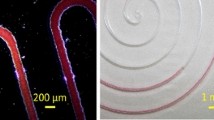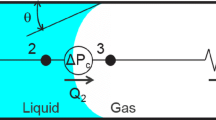Abstract
Capillary microfluidics or capillarics has been lately gaining importance in the biotechnological and biological domains. In these domains where biological and chemical targets are transported by fluids, it has been shown that capillary actuation of fluids does not require bulky pumps or syringes and produces microsystems with a low cost of fabrication, which are user-friendly, portable and compatible with telemedicine. Capillary systems for biotechnology can be confined or open; i.e., the fluid moves inside a closed channel or in a channel with a boundary with air. In this work, we propose a general expression for the determination of the velocities of spontaneous capillary flows in composite, confined microchannels of arbitrary shapes. This expression generalizes the conventional Lucas–Washburn model which is valid for cylindrical channels. It is shown that the use of an equivalent hydraulic diameter in the Lucas–Washburn–Rideal model introduces a bias when the shape of the channel cross section differs notably from a circle. The approach also shows that relatively large velocities—at the scale of microsystems—can be reached by capillary microflows, depending on the shape of the channel, and that transport distances can be important.










Similar content being viewed by others
References
Bahrami M, Yovanovich MM, Culham JR (2007) A novel solution for pressure drop in singly connected microchannels of arbitrary cross-section. Int J Heat Mass Transf 50:2492–2502
Bejan A (2013) Convection heat transfer, 4th edn. Wiley, Hoboken
Bell JM, Cameron FK (1906) The flow of liquids through capillary spaces. J Phys Chem 10:658–674
Berthier J, Brakke K (2012) The physics of microdroplets. Scrivener-Wiley Publishing, New York
Berthier J, Silberzan P (2012) Microfluidics for biotechnology, 2nd edn. Artech House Publishing, London
Berthier J, Renaudot R, Dalle P, Blanco-Gomez G, Rivera F, Agache V, Caillat P (2010) COMSOL assistance for the determination of pressure drops in complex microfluidic channels. In: Proceedings of the 2010 COMSOL conference, Nov. 17–19, Paris, France
Berthier J, Brakke K, Berthier E (2014a) A general condition for spontaneous capillary flow in uniform cross-section microchannels. Microfluid Nanofluid J 16:779–785
Berthier J, Brakke K, Furlani EP, Karampelas IH, Delapierre G (2014b) Open-surface microfluidics. In: Proceedings of the 2014 nanotech conference, 15–19 June 2014, Washington DC
Bruus H (2007) Theoretical microfluidics. Oxford Master Series in Physics. Oxford University Press, Oxford
Concus P, Finn R (1969) On the behavior of a capillary surface in a wedge. PNAS 63(2):292–299
Encyclopedia Britannica. http://www.global.britannica.com
Gervais L, Delamarche E (2009) Toward one-step point-of-care immunodiagnostics using capillary-driven microfluidics and PDMS substrates. Lab Chip 9:3330–3337
Hamraoui A, Thuresson K, Nylander T, Yaminsky V (2000) Can a dynamic contact angle be understood in terms of a friction coefficient? J Colloid Interface Sci 226:199–204
Han A, Mondin G, Hegelbach NG, de Rooij NF, Staufer U (2006) Filling kinetics of liquids in nanochannels as narrow as 27 nm by capillary force. J Colloid Interface Sci 293:151–157
Joos P, Van Remoortere P, Bracke M (1990) The kinetics of wetting in a capillary. J Colloid Interface Sci 136(1):189–197
Kost GJ (2002) Principles and practice of point-of-care testing. Lippincott Williams & Wilkins, Philadelphia
Kotwal N, Pandit A (2012) Variability of capillary blood glucose monitoring measured on home glucose monitoring devices. Indian J Endocrinol Metab 16(Suppl 2):S248–S251
Lucas R (1918) Ueber das Zeitgesetz des Kapillaren Aufstiegs von Flussigkeiten. Kolloid Z 23:15
McHale JP, Garimella SV (2010) Heat transfer in trapezoidal microchannels of various aspect ratios. Int J Heat Mass Transf 53:365–375
Ouali FF, McHale G, Javed H, Trabi C, Shirtcliffe NJ, Newton MI (2013) Wetting considerations in capillary rise and imbibition in closed square tubes and open rectangular cross-section channels. Microfluid Nanofluid 15:309–326
Rideal EK (1922) On the flow of liquids under capillary pressure. Philos Mag Ser 6(44):1152–1159
Rye RR, Yost FG (1996) Wetting kinetics in surface capillary grooves. Langmuir 12:4625–4627
Safavieh R, Juncker D (2013) Capillarics: pre-programmed, self-powered microfluidic circuits built from capillary elements. Lab-Chip 13:4180
Shah RK, London AL (1978) Laminar flow forced convection in ducts. Advances in Heat Transfer Series, Supp. 1. Academic Press, New York
Sharp KV, Adrian RJ, Santiago JG, Molho JI (2005) Liquid flows in microchannels. In: Gad-El-Hak M (ed) MEMS: introduction and fundamentals. CRC Press, Hoboken
Sobolev VD, Churaev NV, Velarde MG, Zorin ZM (2000) Surface tension and dynamic contact angle of water in thin quartz capillaries. J Colloid Interface Sci 222:51–54
Washburn EW (1921) The dynamics of capillary flow. Phys Rev 17:273–283
Weislogel MM (2012) Compound capillary rise. J Fluid Mech 709:622–664
Weislogel MM, Lichter S (1998) Capillary flow in interior corners. J Fluid Mech 373:349–378
Weislogel MM, Chen Y, Bolleddula D (2008) A better nondimensionalization scheme for slender laminar flows: the Laplacian operator scaling method. Phys Fluids 20:093602
Zimmermann M, Schmid H, Hunziker P, Delamarche E (2007) Capillary pumps for autonomous capillary systems. Lab Chip 7:119–125
Zimmermann M, Hunziker P, Delamarche E (2008) Valves for autonomous capillary systems. Microfluid Nanofluid 5:395–402
Author information
Authors and Affiliations
Corresponding author
Appendix: Numerical determination of the Poiseuille number
Appendix: Numerical determination of the Poiseuille number
The numerical determination of the Poiseuille number—or equivalently of the hydraulic resistance—is made by considering a straight channel with the characteristic trapezoidal cross section. The liquid considered in the calculation is water; in fact, the choice of the liquid has no influence on the Poiseuille number since the quantity (1/μ) ∂P/∂z is independent of the nature of the fluid.
At inlet, a given velocity is imposed—for example, 1 mm/s. The Stokes model of the COMSOL numerical software is used to calculate the pressure at the nodes of the meshing in the channel. Let us recall that the Stokes equation results from a linearization of the Navier–Stokes equation valid in the case of a negligible inertia (Re < 1). More precisely, in this particular case, the flow velocity has only a z-component, denoted u, and the Stokes equation is
A linear pressure gradient ∂P/∂z is then derived from the contour plot of the pressure in the channel (Fig. 11). Finally, formula (23) is used to calculate the Poiseuille number after substitution of the value of the pressure gradient. A value of Po = 14.25—i.e., a value of fRe = 57—is found.
Rights and permissions
About this article
Cite this article
Berthier, J., Gosselin, D. & Berthier, E. A generalization of the Lucas–Washburn–Rideal law to composite microchannels of arbitrary cross section. Microfluid Nanofluid 19, 497–507 (2015). https://doi.org/10.1007/s10404-014-1519-3
Received:
Accepted:
Published:
Issue Date:
DOI: https://doi.org/10.1007/s10404-014-1519-3





